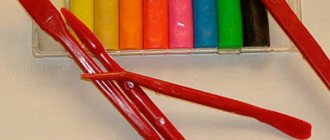Thematic planning in the middle group. Topic of the week: “Gifts from old Lesovik”
Morning.DI. "Let's help Fedora"
Task:
To teach to understand the essence of the concepts: “funny”, “pity”, “to be happy for another”; evoke a desire to be neat. Help Fedora. (N.F. Gubanova “Development of gaming activities” p. 141).
Conversation: “The sky in autumn”
Goal: To be able to notice autumn changes in the sky. Introduce children to the concept of “clouds” and “clouds”.
Articulation gymnastics. Finger gymnastics. Morning exercises.
P/I" "Don't lose the ball" (throwing)
1 GCD Drawing
Topic: “Brave Cockerel”
(drawing based on presentation).
Program content:
Teach children to draw a cockerel with gouache paints, beautifully combining shapes and colors.
Improve your brush technique: move the brush freely and confidently along the pile, repeating the general outline of the silhouette.
Develop observation, sense of color and shape.
Cultivate an interest in reflecting your ideas in the world around you in visual arts.
Literature: Lykova, p.34.
2 GCD FEMP
The first 4 lessons can be devoted to repeating and consolidating the material covered. Lesson 5 Goal. Teach children to distinguish between sets of 1 and 2, 2 and 3 objects based on a one-to-one comparison of their elements; name the total number of items based on the teacher’s count; determine, based on visual comparison, which number is greater and which is less, using appropriate terms; consolidate the ability to identify sides on yourself (right, left arm, leg, shoulder, etc.). Demonstration material: typesetting canvas, 3 squirrels, 3 bunnies and 3 carrots (color images). Handout: on the tables there are 2 vases with flags: for each child 2 blue and 2 red flags (the sticks of the flags are of different thicknesses).. Progress of the lesson. Part 1. 1 bunny is placed on the top strip of the typesetting cloth, and 1 squirrel is placed on the bottom strip. (The squirrel is exactly under the bunny.) The teacher finds out how many squirrels and bunnies there are, then adds 1 more squirrel and says that children will learn not only to distinguish which objects are more and which are fewer, but also to say how many there are, and she will count herself . “How many bunnies? How many squirrels? 1, 2,” the teacher believes, “only 2 squirrels.” With intonation he highlights the total of the count and circles the squirrels with his hand. “Look who has more: bunnies or squirrels? How many squirrels? Who is less? How many bunnies? Children show extra squirrel. The teacher summarizes the children’s answers: “There are 2 squirrels - there are more of them, and there are 1 bunny, there are fewer bunnies than squirrels.” Then he adds a bunny. Finds out how many there are. The teacher counts the bunnies, and then asks: “Are there equal numbers of squirrels and bunnies?” How many squirrels and bunnies? Checks whether the children answered correctly and recounts both groups again. Children name the number of squirrels and bunnies. Then the teacher removes 1 squirrel and finds out how many are left. “How many bunnies? Who is more (less)? Which number is greater (smaller): 1 or 2?” In a similar way, the teacher can compare the number of bunnies and carrots: “Are there enough carrots for the bunnies? How many are there?” Etc. Part 2 (physical education minute). The teacher invites the children to stand up and put their hands down. With your right hand, touch your right ear, with your left hand, touch your left ear; touch your right knee with your right hand, touch your left knee with your left; touch your right shoulder with your right hand, touch your left shoulder with your left hand. Part 3 (work with handouts). The teacher invites the children to show their right hand, left hand. Take 1 blue flag in your left hand, and 2 red flags in your right hand. He asks: “Which flags did you take more? How many are there? Which ones are smaller? How many are there?” Then invites the children to take 1 more blue flag. He asks how many flags there are now of each color. Next, first place a red and then a blue flag in the vase. Each time the number of flags is compared. After the children have 1 blue and 1 red flag left, the teacher asks which flag has a thicker (thinner) stick, and offers to place first a flag on a thin stick and then a flag on a thick stick in the vase.
